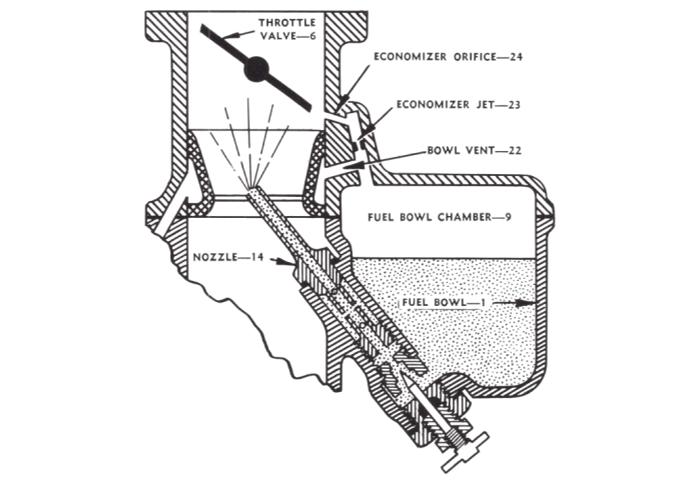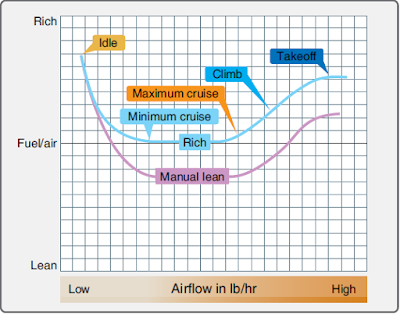Please help me understand the Marvel Schebler Economizer circuit.
If I read things correctly, carburetors normally have the space above the fuel bowl vented to ambient(-ish) air pressure. There's a fuel nozzle in the Venturi and the Venturi has an air pressure inversely proportional to the speed of the air flowing through it. Therefore, the rate at which fuel is sucked out of the fuel bowl through the nozzle is a function of the differential between the venturi's air pressure and the fuel bowl's air pressure.

Marvel Schebler's Economizer adds a passage between the fuel bowl's air space and the throttle body. At full throttle the manifold pressure is near ambient so the Economizer doesn't do much since the air pressure on both sides of the passage are near equal. As you go to a lesser throttle setting, the manifold pressure decreases, which sucks some of the air out of the fuel bowl chamber through the Economizer passage. The decreased air pressure differential between the venturi and the fuel bowl chamber results in less fuel getting sucked through the nozzle, hence a leaner mixture ratio.
Q1: Did I get this right?
Q2: Without the Economizer, would the air/fuel mixture ratio be constant throughout the throttle range?
Q3: If the Economizer were to be disabled, would there be an effect on engine smoothness or even its ability to stay running?
Q4: Does the Economizer really save any fuel? Once settled into cruise with a fixed throttle setting, what's the difference between the Economizer leaning the mixture and the pilot leaning the mixture with the red knob?
Regarding the enrichment circuit, I've heard it said that if you pull back a little bit from full throttle that you disable the enrichment circuit and thus save a bit of fuel.
Q5: Is this really true?
Q6: How does the enrichment circuit work?
Q7: How is disabling the enrichment circuit different from the pilot merely pulling back on the mixture knob?
If I read things correctly, carburetors normally have the space above the fuel bowl vented to ambient(-ish) air pressure. There's a fuel nozzle in the Venturi and the Venturi has an air pressure inversely proportional to the speed of the air flowing through it. Therefore, the rate at which fuel is sucked out of the fuel bowl through the nozzle is a function of the differential between the venturi's air pressure and the fuel bowl's air pressure.

Marvel Schebler's Economizer adds a passage between the fuel bowl's air space and the throttle body. At full throttle the manifold pressure is near ambient so the Economizer doesn't do much since the air pressure on both sides of the passage are near equal. As you go to a lesser throttle setting, the manifold pressure decreases, which sucks some of the air out of the fuel bowl chamber through the Economizer passage. The decreased air pressure differential between the venturi and the fuel bowl chamber results in less fuel getting sucked through the nozzle, hence a leaner mixture ratio.
Q1: Did I get this right?
Q2: Without the Economizer, would the air/fuel mixture ratio be constant throughout the throttle range?
Q3: If the Economizer were to be disabled, would there be an effect on engine smoothness or even its ability to stay running?
Q4: Does the Economizer really save any fuel? Once settled into cruise with a fixed throttle setting, what's the difference between the Economizer leaning the mixture and the pilot leaning the mixture with the red knob?
Regarding the enrichment circuit, I've heard it said that if you pull back a little bit from full throttle that you disable the enrichment circuit and thus save a bit of fuel.
Q5: Is this really true?
Q6: How does the enrichment circuit work?
Q7: How is disabling the enrichment circuit different from the pilot merely pulling back on the mixture knob?




